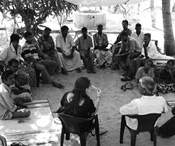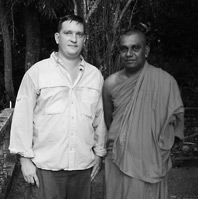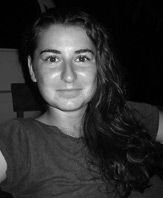Tsunami Response: Alumni in Sri Lanka
Open gallery

Allen Hall MA ‘06, Satya Byock ‘04
Shell-shocked by graphic TV images, the world watched in horror as footage of the December 26, 2004, tsunami hit the airways. Triggered by the Indian Ocean’s most powerful earthquake in 40 years, a massive wall of water ravaged dozens of countries, killed hundreds of thousands of people, and drove more than a million residents from their homes.
To Allen Hall and Satya Byock, the disaster felt deeply personal.
Both had recently lived in the region. Hall had taught English and traveled in Thailand in 2001 and 2002. Byock had taught English to poor rural kindergarteners at a Sri Lankan Buddhist temple in 2002. Independently, each felt compelled to return in mid-February to help with short-term relief and long-term empowerment efforts.

Hall Coordinates Tsunami Response Initiative
In January, bleary-eyed from endless hours of Web research and blogging, Allen Hall compiled critical information for the Tsunami Response Initiative at the Lewis & Clark Graduate School of Education and Counseling. The initiative, a project of the Oregon Center for Inquiry and Social Innovation, offers Web links to volunteer opportunities; relief organizations and efforts; teaching and counseling resources; and, following his subsequent trip to Sri Lanka, Hall’s own journals.
While researching how to help, Hall aimed first to do no harm. After members of Portland’s Sri Lankan community assured him that his assistance would be welcomed, Hall found Architects Without Borders through friends heÕd met on the Web. The fledgling Portland-based group planned to build a new primary school in Bata Atha. Hall, who had construction experience, decided to join them.
On February 22, he boarded a plane for Sri Lanka. Racked with fever and near delirium caused by acute bronchitis, Hall received medical treatment upon his arrival. Nine hours later, he met with the country’s assistant secretary to the prime minister, who helped the team circumvent miles of bureaucratic red tape related to land acquisition, public utility access, and construction permits.
During his 17-day stint, as he drove from the ravaged shoreline through the country’s lush interior, Hall often stopped to talk with villagers relocated in temporary tent settlements.
“My first instinct when meeting survivors was to empty my pockets of all my money, then sit down and cry with them,” he says. Instead, Hall, who is pursuing a master’s degree in counseling psychology, used listening skills he’d learned while at Lewis & Clark, particularly during a pre-trip workshop on critical incident stress management and post-trauma counseling.
“The individual’s personal narrative tells you everything,” says Hall. “Creating the space for a person to give birth to this narrative–while you help him or her examine it–can be powerfully therapeutic.”
While in Sri Lanka, Hall also distributed school supplies and other sundries, all of which had been collected through Lewis & Clark’s Tsunami Response Initiative, the Portland Sri Lankan community, and the Sri Lanka Relief Fund of Omaha, Nebraska.

Byock Joins Missoula Community Tsunami Response
With the support of family, friends, and neighbors, Satya Byock helped to establish the Missoula Community Tsunami Response. The group aimed to educate its Montana community, connect with small donors, and support tsunami survivors. Before heading to Sri Lanka, Byock gave more than a dozen presentations at local schools and promised to write home and keep people informed about the effects of the disaster.
In mid-February, she joined a group of fellow Montanans already on the ground in Komari, a fishing village that had been reduced to rubble on Sri Lanka’s east coast.
She worked tirelessly, developing and assisting with programs that supported local initiatives, including training classes on advanced farming technologies designed to increase yield and income.
“Thanks to the refreshing dedication of local leaders and agriculture experts, Komari farmers and homeowners are steadily reestablishing their livelihoods,” Byock says.
Barbed wire now protects homesteads from roaming cattle and elephants. Residents are developing composting projects to support crops and also aid in waste management. And area farmers have established the Komari Agricultural Development Society to move beyond subsistence farming and to build sustainable programs and practices.
Aftermath: Back in the U.S.
As Byock dreams of returning to Sri Lanka, she’s busy directing Education for Development, a nonprofit organization that supports schools, students, cultural exchange, and service programs in the United States and in developing nations.
Hall is completing summer coursework and will return to Sri Lanka in early August. He and a small contingent from Lewis & Clark’s graduate school will work with Sarvodaya, the largest and best-known nongovernmental organization (NGO) in Sri Lanka. He will also work with a Portland couple, Jan and Gary Woodruff, to establish Rebuilding Community International (www.rebuildingcommunity.org). Hall says this NGO will address community driven needs and build sustainable infrastructure related to green building, village cooperatives, and microeconomic projects.
“Images of the disaster are fading from TV news, but the need persists,” Hall says. “Everyone still has a part to play.”
–by Pattie Pace
More L&C Magazine Stories
Lewis & Clark Magazine is located in McAfee on the Undergraduate Campus.
MSC: 19
email magazine@lclark.edu
voice 503-768-7970
fax 503-768-7969
The L&C Magazine staff welcomes letters and emails from readers about topics covered in the magazine. Correspondence must include your name and location and may be edited.
Lewis & Clark Magazine
Lewis & Clark
615 S. Palatine Hill Road MSC 19
Portland OR 97219

